air condition Lancia Musa 2009 Owner handbook (in English)
[x] Cancel search | Manufacturer: LANCIA, Model Year: 2009, Model line: Musa, Model: Lancia Musa 2009Pages: 218, PDF Size: 3.7 MB
Page 133 of 218
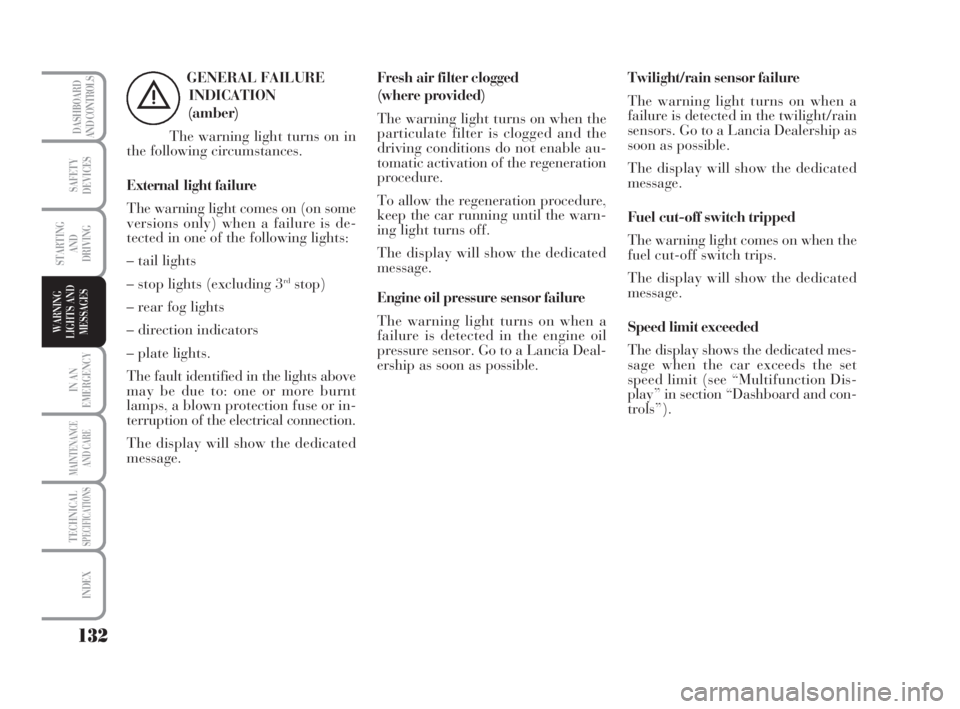
132
IN AN
EMERGENCY
MAINTENANCE
AND CARE
TECHNICALSPECIFICATIONS
INDEX
DASHBOARD
AND CONTROLS
SAFETY
DEVICES
STARTING
AND
DRIVING
WARNING
LIGHTS AND
MESSAGES
GENERAL FAILURE
INDICATION
(amber)
The warning light turns on in
the following circumstances.
Externallight failure
The warning light comes on (on some
versions only) when a failure is de-
tected in one of the following lights:
– tail lights
– stop lights (excluding 3
rdstop)
– rear fog lights
– direction indicators
– plate lights.
The fault identified in the lights above
may be due to: one or more burnt
lamps, a blown protection fuse or in-
terruption of the electrical connection.
The display will show the dedicated
message.
è
Fresh air filter clogged
(where provided)
The warning light turns on when the
particulate filter is clogged and the
driving conditions do not enable au-
tomatic activation of the regeneration
procedure.
To allow the regeneration procedure,
keep the car running until the warn-
ing light turns off.
The display will show the dedicated
message.
Engine oil pressure sensor failure
The warning light turns on when a
failure is detected in the engine oil
pressure sensor. Go to a Lancia Deal-
ership as soon as possible.Twilight/rain sensor failure
The warning light turns on when a
failure is detected in the twilight/rain
sensors. Go to a Lancia Dealership as
soon as possible.
The display will show the dedicated
message.
Fuel cut-off switch tripped
The warning light comes on when the
fuel cut-off switch trips.
The display will show the dedicated
message.
Speed limit exceeded
The display shows the dedicated mes-
sage when the car exceeds the set
speed limit (see “Multifunction Dis-
play” in section “Dashboard and con-
trols”).
125-134 MUSA 1ed GB 10-07-2008 9:38 Pagina 132
Page 167 of 218
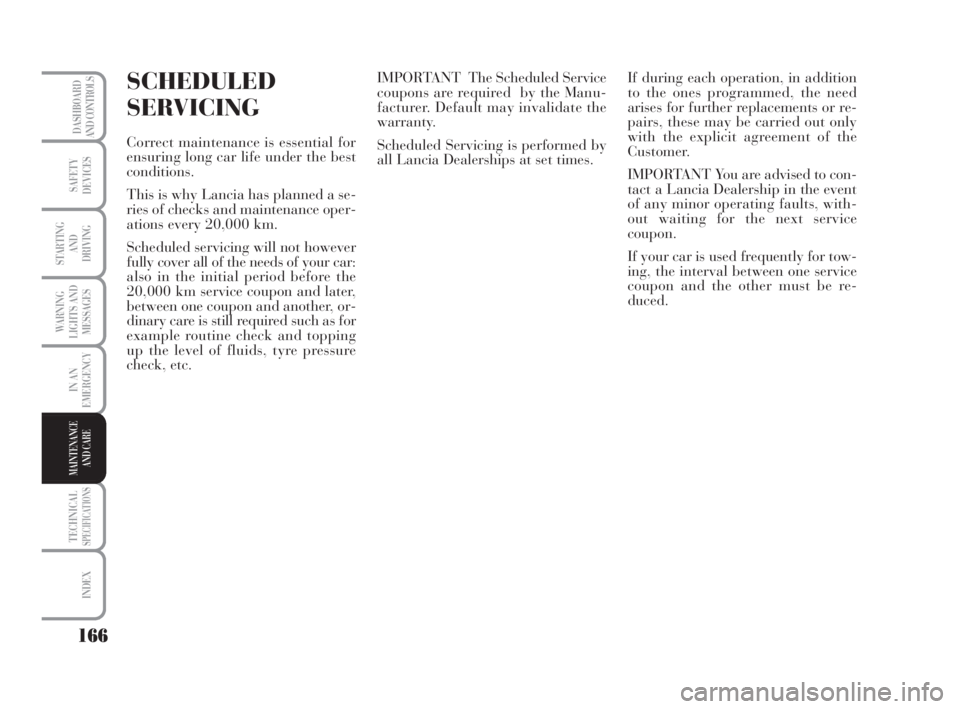
166
WARNING
LIGHTS AND
MESSAGES
TECHNICALSPECIFICATIONS
INDEX
DASHBOARD
AND CONTROLS
SAFETY
DEVICES
STARTING
AND
DRIVING
IN AN
EMERGENCY
MAINTENANCE
AND CARE
SCHEDULED
SERVICING
Correct maintenance is essential for
ensuring long car life under the best
conditions.
This is why Lancia has planned a se-
ries of checks and maintenance oper-
ations every 20,000 km.
Scheduled servicing will not however
fully cover all of the needs of your car:
also in the initial period before the
20,000 km service coupon and later,
between one coupon and another, or-
dinary care is still required such as for
example routine check and topping
up the level of fluids, tyre pressure
check, etc. IMPORTANT The Scheduled Service
coupons are required by the Manu-
facturer. Default may invalidate the
warranty.
Scheduled Servicing is performed by
all Lancia Dealerships at set times. If during each operation, in addition
to the ones programmed, the need
arises for further replacements or re-
pairs, these may be carried out only
with the explicit agreement of the
Customer.
IMPORTANT You are advised to con-
tact a Lancia Dealership in the event
of any minor operating faults, with-
out waiting for the next service
coupon.
If your car is used frequently for tow-
ing, the interval between one service
coupon and the other must be re-
duced.
165-186 MUSA 1ed GB 10-07-2008 9:39 Pagina 166
Page 169 of 218
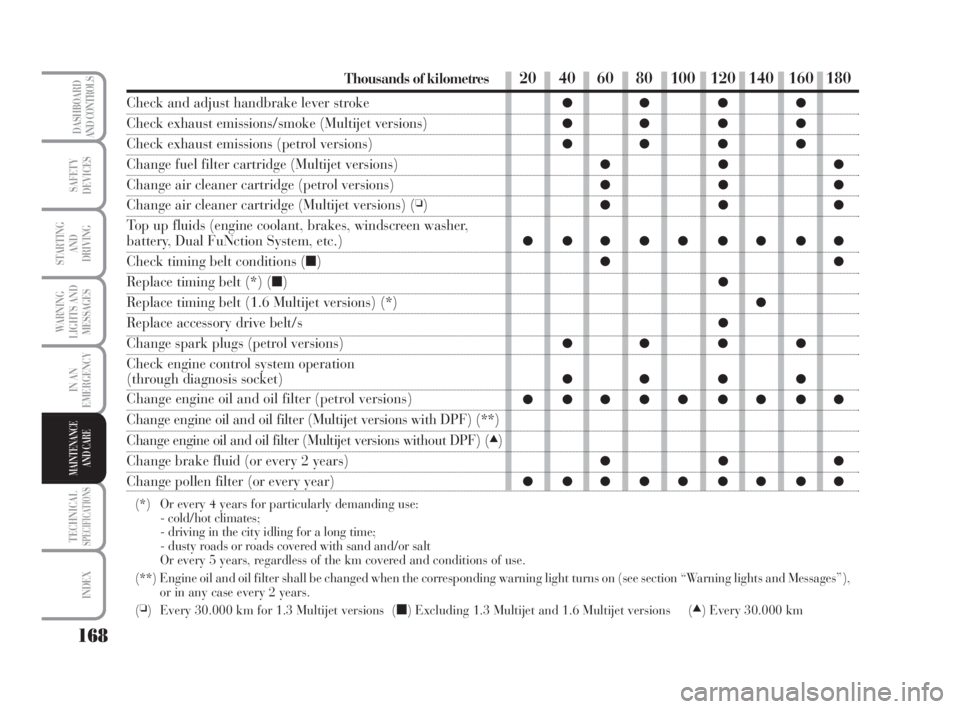
168
WARNING
LIGHTS AND
MESSAGES
TECHNICALSPECIFICATIONS
INDEX
DASHBOARD
AND CONTROLS
SAFETY
DEVICES
STARTING
AND
DRIVING
IN AN
EMERGENCY
MAINTENANCE
AND CARE
Thousands of kilometres
Check and adjust handbrake lever stroke
Check exhaust emissions/smoke (Multijet versions)
Check exhaust emissions (petrol versions)
Change fuel filter cartridge (Multijet versions)
Change air cleaner cartridge (petrol versions)
Change air cleaner cartridge (Multijet versions) (❏)
Top up fluids (engine coolant, brakes, windscreen washer,
battery, Dual FuNction System, etc.)
Check timing belt conditions (■)
Replace timing belt (*) (■)
Replace timing belt (1.6 Multijet versions) (*)
Replace accessory drive belt/s
Change spark plugs (petrol versions)
Check engine control system operation
(through diagnosis socket)
Change engine oil and oil filter (petrol versions)
Change engine oil and oil filter (Multijet versions with DPF) (**)
Change engine oil and oil filter (Multijet versions without DPF) (▲)
Change brake fluid (or every 2 years)
Change pollen filter (or every year)
(*) Or every 4 years for particularly demanding use:
- cold/hot climates;
- driving in the city idling for a long time;
- dusty roads or roads covered with sand and/or salt
Or every 5 years, regardless of the km covered and conditions of use.
(**) Engine oil and oil filter shall be changed when the corresponding warning light turns on (see section “Warning lights and Messages”),
or in any case every 2 years.
(
❏) Every 30.000 km for 1.3 Multijet versions (■) Excluding 1.3 Multijet and 1.6 Multijet versions (▲) Every 30.000 km
20 40 60 80 100 120 140 160 180
●● ● ●
●● ● ●
●● ● ●
●●●
●●●
●●●
●●●●● ●●●●
●●
●
●
●
●● ● ●
●● ● ●
●●●●● ●●●●
●●●
●●●●● ●●●●
165-186 MUSA 1ed GB 10-07-2008 9:39 Pagina 168
Page 171 of 218
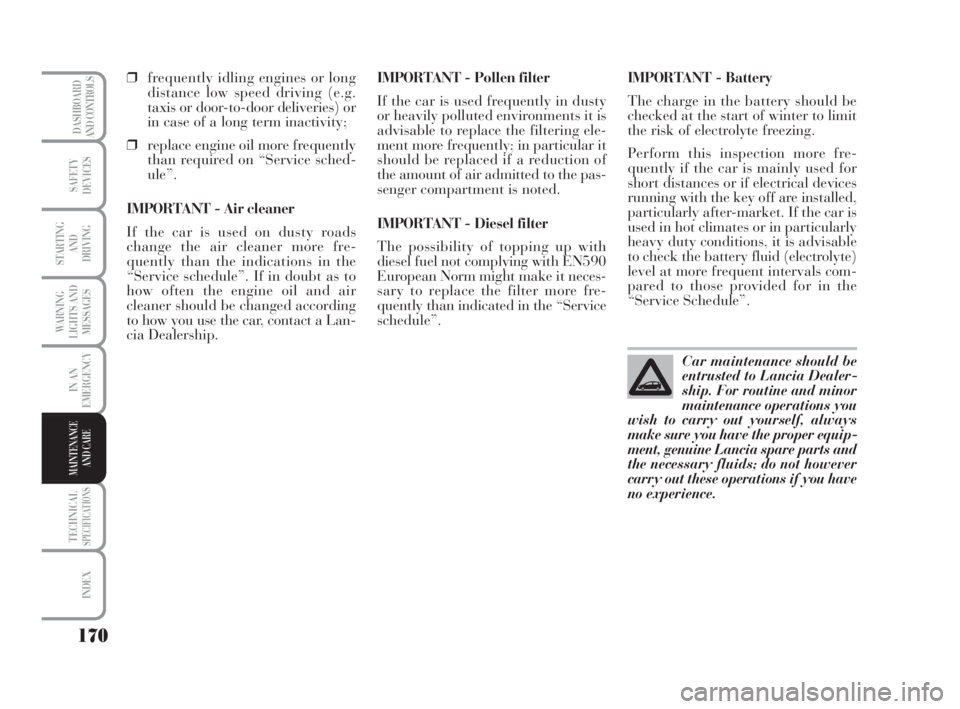
170
WARNING
LIGHTS AND
MESSAGES
TECHNICALSPECIFICATIONS
INDEX
DASHBOARD
AND CONTROLS
SAFETY
DEVICES
STARTING
AND
DRIVING
IN AN
EMERGENCY
MAINTENANCE
AND CARE
❒frequently idling engines or long
distance low speed driving (e.g.
taxis or door-to-door deliveries) or
in case of a long term inactivity;
❒replace engine oil more frequently
than required on “Service sched-
ule”.
IMPORTANT - Air cleaner
If the car is used on dusty roads
change the air cleaner more fre-
quently than the indications in the
“Service schedule”. If in doubt as to
how often the engine oil and air
cleaner should be changed according
to how you use the car, contact a Lan-
cia Dealership.IMPORTANT - Pollen filter
If the car is used frequently in dusty
or heavily polluted environments it is
advisable to replace the filtering ele-
ment more frequently; in particular it
should be replaced if a reduction of
the amount of air admitted to the pas-
senger compartment is noted.
IMPORTANT - Diesel filter
The possibility of topping up with
diesel fuel not complying with EN590
European Norm might make it neces-
sary to replace the filter more fre-
quently than indicated in the “Service
schedule”.IMPORTANT - Battery
The charge in the battery should be
checked at the start of winter to limit
the risk of electrolyte freezing.
Perform this inspection more fre-
quently if the car is mainly used for
short distances or if electrical devices
running with the key off are installed,
particularly after-market. If the car is
used in hot climates or in particularly
heavy duty conditions, it is advisable
to check the battery fluid (electrolyte)
level at more frequent intervals com-
pared to those provided for in the
“Service Schedule”.
Car maintenance should be
entrusted to Lancia Dealer-
ship. For routine and minor
maintenance operations you
wish to carry out yourself, always
make sure you have the proper equip-
ment, genuine Lancia spare parts and
the necessary fluids; do not however
carry out these operations if you have
no experience.
165-186 MUSA 1ed GB 10-07-2008 9:39 Pagina 170
Page 183 of 218
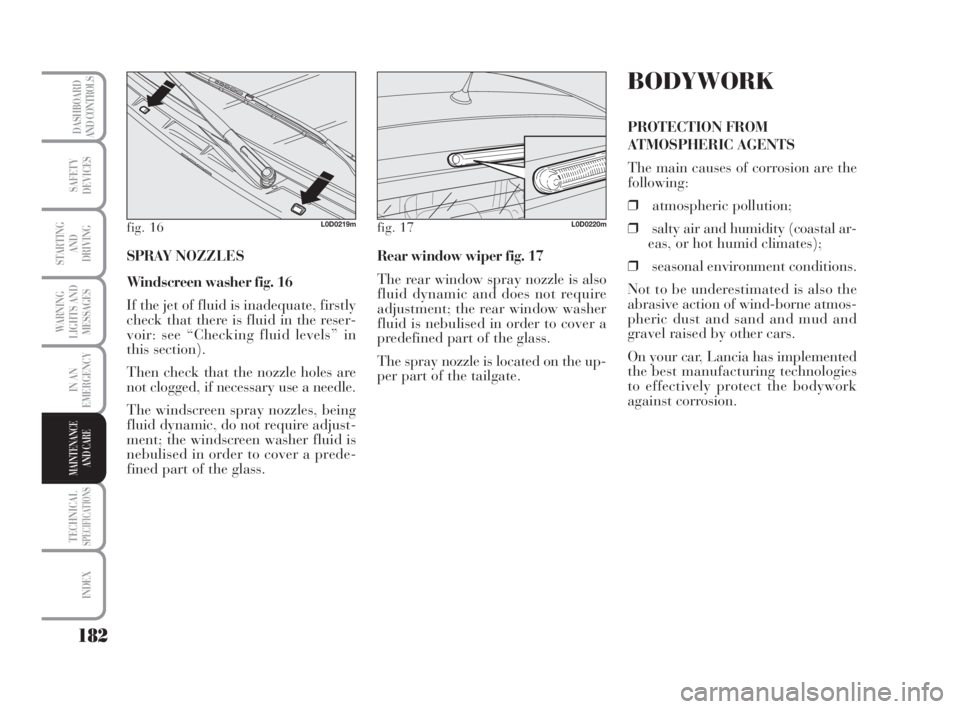
182
WARNING
LIGHTS AND
MESSAGES
TECHNICALSPECIFICATIONS
INDEX
DASHBOARD
AND CONTROLS
SAFETY
DEVICES
STARTING
AND
DRIVING
IN AN
EMERGENCY
MAINTENANCE
AND CARE
SPRAY NOZZLES
Windscreen washer fig. 16
If the jet of fluid is inadequate, firstly
check that there is fluid in the reser-
voir: see “Checking fluid levels” in
this section).
Then check that the nozzle holes are
not clogged, if necessary use a needle.
The windscreen spray nozzles, being
fluid dynamic, do not require adjust-
ment; the windscreen washer fluid is
nebulised in order to cover a prede-
fined part of the glass.Rear window wiper fig. 17
The rear window spray nozzle is also
fluid dynamic and does not require
adjustment; the rear window washer
fluid is nebulised in order to cover a
predefined part of the glass.
The spray nozzle is located on the up-
per part of the tailgate.
BODYWORK
PROTECTION FROM
ATMOSPHERIC AGENTS
The main causes of corrosion are the
following:
❒atmospheric pollution;
❒salty air and humidity (coastal ar-
eas, or hot humid climates);
❒seasonal environment conditions.
Not to be underestimated is also the
abrasive action of wind-borne atmos-
pheric dust and sand and mud and
gravel raised by other cars.
On your car, Lancia has implemented
the best manufacturing technologies
to effectively protect the bodywork
against corrosion.
fig. 16L0D0219mfig. 17L0D0220m
165-186 MUSA 1ed GB 10-07-2008 9:39 Pagina 182
Page 205 of 218

204
WARNING
LIGHTS AND
MESSAGES
INDEX
DASHBOARD
AND CONTROLS
SAFETY
DEVICES
STARTING
AND
DRIVING
IN AN
EMERGENCY
MAINTENANCE
AND CARE
TECHNICALSPECIFICATIONS
FUEL CONSUMPTION
The fuel consumption figures given in the table below are determined on the basis of the homologation tests set down
by specific European Directives.
The procedures below are followed for measuring consumption:
❒urban cycle: cold starting followed by driving that simulates urban use of the car;
❒extraurban cycle: frequent accelerations in all gears, simulating extraurban use of the car: speed varies between 0
and 120 km/h;
❒combined consumption: calculated weighing about 37% of urban cycle consumption and about 63% of extraurban
consumption.
IMPORTANT The type of route, traffic situations, weather conditions, driving style, general conditions of the car, trim
level/equipment/accessories, load, climate control system, roof rack, other situations that affect air drag may lead to
different fuel consumption levels than those measured.
Fuel consumption according to Directive 1999/100/EC(litres x 100 km)Urban Extraurban Combined
1.48V(▲) 7.9 5.2 6.5
1.416V(5 gears) 8.5 5.5 6.6
1.416V(6 gears) 8.7 5.4 6.6
1.3 Multijet 70HP 5.7 4.0 4,6
1.3 Multijet 90HP 5.8 3.9 4.6
1.6 Multijet 6.2 4.2 4.9
(
▲) Engine provided for some versions/markets only
187-205 MUSA 1ed GB 10-07-2008 9:40 Pagina 204